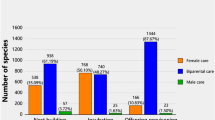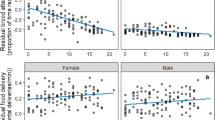Abstract
Avian nest building has traditionally been viewed as resulting in natural selection advantages, but it is also been associated with courtship and pair formation. We hypothesize that nest-building activity could be used as a sexually selected display, allowing each sex to obtain reliable information on the condition of the other. In this paper, we test the ‘good parent’ process in a scenario where nest size is a sexually selected trait. Thus, individuals with more extreme displays (larger nests) might obtain benefits in terms of either parental investment or differential parental investment by the partner. We predicted that: (1) species in which both sexes contribute to nest building have larger nests than those in which the nest is built only by one sex, because both sexes are using the nest-building process as a signal of their quality; (2) species in which both sexes work together in the nest-building process invest more in reproduction, because each can assess the other more reliably than in species where only one sex participates in nest building; and (3) in light of the two preceding predictions, nest size should be positively related to investment in parental care. A comparative analysis of 76 passerine species confirmed that nest size, relative to the species' body size, is larger when both sexes build the nest and that species with a larger nest relative to their body size invest more in reproduction.
Similar content being viewed by others
References
Bishir, J., Lancia, R.A. and Hodgdon, H.E. (1983) Beaver family organization: Its implications for colony size. In Investigation on Beavers, Vol. I (G. Pilleri, ed.), pp. 105–113. Brain Anatomy Institute, Berne.
Borgia, G. (1987) A critical review of sexual selection models. In Sexual Selection: Testing the Alternatives (J.W. Bradbury and M.B. Andersson, eds), pp. 55–66. John Wiley, New York.
Bosque, C. and Bosque, M.T. (1995) Nest predation as a selective factor in the evolution of developmental rates in altricial birds. Am. Nat. 145, 234–260.
Burley, N. (1986) Sexual selection for aesthetic traits in species with biparental care. Am. Nat. 127, 415–445.
Clutton-Brock, T.H. (1991) The Evolution of Parental Care. Princeton University Press, Princeton, NJ.
Collias, N.E. (1964) The evolution of nests and nest-building in birds. Am. Zool. 4, 175–190.
Collias, N.E. and Collias, E.C. (1984) Nest Building and Bird Behaviour. Princeton University Press, Princeton, NJ.
Cramp, S. (1985–92) The Birds of the Western Palaearctic, Vols 5–7. Oxford University Press, Oxford.
Cramp, S. and Perrins, C.M. (1993–94) The Birds of the Western Palaearctic, Vols 8–9. Oxford University Press, Oxford.
Dementiev, G.P. and Gladkov, N.A. (eds) (1966–68) Birds of the Soviet Union. Israeli Program for Scientific Translations, Jerusalem.
Felsenstein, J. (1985) Phylogenies and the comparative method. Am. Nat. 125, 1–15.
Garland, T. Jr, Dickerman, A.W., Janis, C.M. and Jones, J.A. (1993) Phylogenetic analysis of covariance by computer simulation. Syst. Biol. 42, 2665–2692.
Haftorn, S. (1971) Norges Fugler. Universitetsforlaget, Oslo.
Hansell, M.H. (1984) Animal Architecture and Building Behaviour. Longman, London.
Harrison, C.J.O. (1975) Field Guide to the Nest, Eggs and Nestlings of European Birds. Collins, London.
Harvey, P.H. and Pagel, M. (1991) The Comparative Method in Evolutionary Biology. Oxford University Press, Oxford.
Hastings, P.A. (1988) Female choice and male reproductive success in the angel blenny, Coralliocetus angelica (Teleostei: Chaenopsidae). Anim. Behav. 36, 115–124.
Hoi, H., Schleicher, B. and Valera, F. (1994) Female mate choice and nest desertion in penduline tits, Remiz pendulinus: The importance of nest quality. Anim. Behav. 48, 743–746.
Hoi, H., Schleicher, B. and Valera, F. (1996) Nest size variation and its importance for mate choice in penduline tits, Remiz pendulinus. Anim. Behav. 51, 464–466.
Howard, R. and Moore, A. (1991) A Complete Checklist of the Birds of the World. Academic Press, San Diego, CA.
Johnsen, I., Erikstad, K.E. and Sæter, B.-E. (1994) Regulation of parental investment in a long-lived seabird, the puffin Fratercula artica: An experiment. Oikos 71, 273–278.
Kern, M.D. (1984) Racial differences in nests of white-crowned sparrows. Condor 86, 455–466.
Kern, M.D. and Riper III, C. (1984) Altitudinal variation in the Hawaiian honeycreeper Hemignatus virens virens. Condor 86, 443–454.
Kraak, S.B.M. and Videler, J.J. (1991) Female mate choice in Aidablennius sphynx (Teleostei, Blenniidae): Females prefer nests containing more eggs. Behaviour 119, 243–266.
Kraak, S.B.M. and van den Berghe, E.P. (1992) Do female fish assess paternal quality by means of test eggs? Anim. Behav. 43, 865–867.
Lack, D. (1954) The Natural Regulation of Animal Numbers. Clarendon Press, Oxford.
Lack, D. (1968) Ecological Adaptations for Breeding in Birds. Methuen, London.
Lima, S.L. (1987) Clutch size in birds: A predation perspective. Ecology 68, 1062–1070.
Møller, A.P. (1982) Clutch size in relation to nest size in the swallow Hirundo rustica. Ibis 124, 339–343.
Møller, A.P. (1994) Sexual Selection and the Barn Swallow. Oxford University Press, Oxford.
Møller, A.P., Lindén, M., Soler, J.J., Soler, M. and Moreno, J. (1995) Morphological adaptations to an extreme sexual display, stone-carrying in the black wheatear Oenanthe leucura. Behav. Ecol 6, 368–375.
Moreno, J., Soler, M., Møller, A.P. and Lindén, M. (1994) The function of stone carrying in the black wheatear, Oenanthe leucura. Anim. Behav. 47, 1297–1309.
Niethammer, G. (1937) Handbuch der deutschen Vogelkunde. Akademische Verlagsgesellschaft, Leipzig.
Perrins, C. (1987) Nueva generación de guías: Aves de España y de Europa. Omega, Barcelona.
Pikula, J. (1979) Die Lage und Zusammensetzung der Nester von Turdus philomelos in der CSSR. Zoologické Listy 19, 163–196.
Pitcher, T.J. (1993). Behaviour of Teleost Fishes, 2nd edn. Chapman & Hall, London.
Purvis, A. (1991) Comparative Analysis by Independent Contrasts, Version 1.2: User's Guide. Oxford University Press, Oxford.
Purvis, A. and Garland, T. Jr (1993) Polytomies in comparative analyses of continuous characters. Syst. Biol. 42, 569–575.
Sciurine, C. and Kern, M. (1980) The insulation in nests of selected North American songbirds. Auk 97, 816–824.
Sibley, C.G. and Ahlquist, J.E. (1990) Phylogeny and Classification of Birds: A Study of Molecular Evolution. Yale University Press, New Haven, CT.
Slagsvold, T. (1982) Clutch size, nest size, and hatching asynchrony in birds: Experiments with the fieldfare (Turdus pilaris). Ecology 63, 1389–1399.
Slagsvold, T. (1984) Clutch size variation in birds in relation to nest predation: On the cost of reproduction. J. Anim. Ecol. 53, 945–953.
Slagsvold, T. (1989a) On the evolution of clutch size and nest size in passerine birds. Oecologia 79, 300–305.
Slagsvold, T. (1989b) Experiment on clutch size and nest size in passerine birds. Oecologia 80, 297–302.
Snow, D.W. (1978) The nest as a factor determining clutch-size in tropical birds. J. Ornithol. 119, 227–230.
Soler, J.J., Soler, M., Møller, A.P. and Martínez, J.G. (1995) Does the great spotted cuckoo choose magpie hosts according to their parenting ability? Behav. Ecol. Sociobiol. 36, 201–206.
Soler, M., Soler, J.J., Møller, A.P., Moreno, J. and Lindén, M. (1996) An experimental analysis of the functional significance of an extreme sexual display: Stone-carrying in the black wheatear Oenanthe leucura. Anim. Behav. 51, 247–254.
Sæther, B.E. (1994) Reproductive strategies in relation to prey size in altricial birds: Homage to Charles Elton. Am. Nat. 144, 285–299.
Tortosa, F.S. and Redondo, T. (1992) Frequent copulations despite low sperm competition in white storks (Ciconia ciconia). Behaviour 121, 288–315.
Walsberg, G.E. and King, J.R. (1978) The energetic consequences of incubation for two passerine species. Auk 95, 644–655.
Warren, E.R. (1927). The beaver. Am. Soc. Mammal. 2, 1–72.
Whittow, G.C. and Berger, A.J. (1977) Heat loss from the nest of the Hawaiian honeycreeper, ‘Amakihi’. Wilson Bull. 89, 480–483.
Winkler, D.W. and Wilkinson, G.S. (1988) Parental effort in birds and mammals: Theory and measurement. In Oxford Surveys in Evolutionary Biology, Vol. 5 (P.H. Harvey and L. Partridge, eds), pp.185–214. Oxford University Press, New York.
Zahavi, A. (1987) The theory of signal selection and some of its implications. In Proceedings of the Interna-tional Symposium on Biological Evolution (V.P. Delfino, ed.), pp. 305–327. Adriatica Editrice, Bari.
Author information
Authors and Affiliations
Rights and permissions
About this article
Cite this article
Soler, J.J., MØLler, A.P. & Soler, M. Nest building, sexual selection and parental investment. Evolutionary Ecology 12, 427–441 (1998). https://doi.org/10.1023/A:1006520821219
Issue Date:
DOI: https://doi.org/10.1023/A:1006520821219




